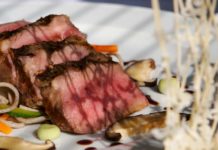
The idea of cooking ribeye steaks sometimes conjures up an image of a blazing campfire with a pot of beans and another of corn on the cob. It’s a hearty meal that excites the taste buds and fills the belly. Meanwhile the soul is fed with campfire stories late into the evening. It’s an evening to remember.
And that’s exactly what you want any time you cook steaks – an evening that’s memorable.
So how do you start?Well, according to food experts, ribeye steaks and the boned loin cuts are two of the best skillet steaks and neither one really needs any marination. Just get out your heavy-duty iron skillet, add a little salt and pepper, start cooking the ribeye steaks and let the meat speak with its own flavor.
In fact, there’s really not a whole lot of other things you need to know about cooking ribeye steaks with the exception of the fact that they are best cooked whole, then sliced before serving. Of course you can always let your guests slice their own meat.
With those facts as your two only important basic facts to know, now it’s time to get a little exotic and experiment with the flavor of a nice big 1-1/2 inch thick ribeye steak. Here are some ways to turn up the taste:
Brush clarified butter on steaks before cooking, or afterwards.
Clarified butter is butter that can be heated to high temperatures without risk of burning. If you’ve ever tasted an egg fried in butter that burnt, you’re familiar with the burnt butter taste that ruins the egg.
To make clarified butter, melt a solid stick of butter in a saucepan at very low heat. Then skim off the solids. These solids are what burn at high temperature. Chefs then let the butter harden and melt it again, repeating this process four or more times until the final product looks like a clear yellow liquid. This can be brushed on steaks before or after cooking to enhance the flavor.
Use a marinade.
Although the process of cooking ribeye steaks really doesn’t need additional flavor, some people have taste buds that demand more flavor! That’s when the marinades come in handy. You can find recipes for marinades in cookbooks or online and if you’re a little daring, why not attempt to create one on your own?
The basic ingredients of marinades can be:
- vinegar with one to five herbs added to it
- soy sauce with sugar or sweetener and an herb or two
- lemon juice with an herb or two added to it.
Mix about a cup of the fluid with your choice of herbs in a bowl or flat pie pan, add the meat, and let it sit in the refrigerator for 4 to 6 hours or even overnight. Occasionally, turn the meat so the flavor is distributed evenly. Then cook the ribeye steak as usual.
Make a dry rub.
To make dry rubs, mix together several herbs in a small bowl. Your choice of herbs could be garlic, rosemary, thyme, sage, basil, oregano, freshly ground pepper, freshly milled coarse salt. Taste the final mixture and if it passes your taste bud scrutiny, rub it onto the ribeye steaks for dinner. If it doesn’t pass your taste test, add a few additional herbs or increase one of the herbs so that it becomes the predominant taste.
Dry rubs should be left on the meat for about 30 minutes prior to cooking for best flavor.
After you’ve selected one of these three primary methods to boost flavor, it’s time to cook the meat. Fire up the charcoals or the gas grill, or even your kitchen stove. Only when the fire is hot enough (between 400 and 500 degrees Fahrenheit), add the ribeye steaks that have been sitting at room temperature for at least 30 minutes. Cook for at least 2 to 3 minutes per side for rare; 4 to 5 minutes per side for medium, and 7 to 10 minutes per side for well done. Serve your ribeye steaks on warmed plates.
So when was the last time you had fun cooking ribeye steaks? Aren’t you aching for one right now?





